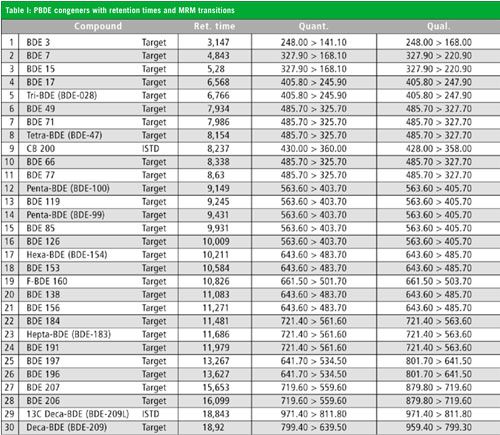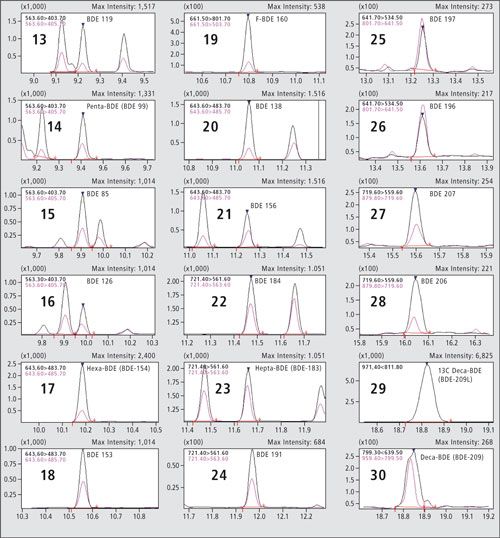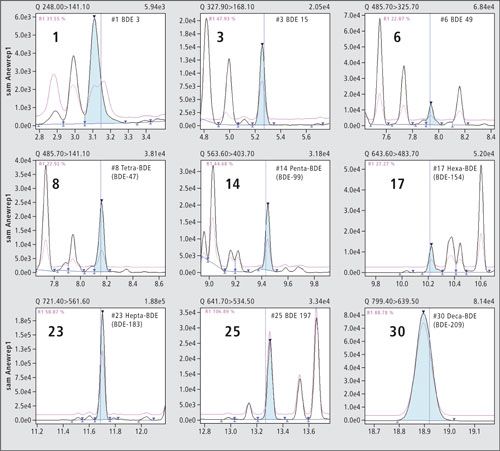Determination of PBDE Congeners Using GCMS-TQ8050
Special Issues
Determination of PBDE congeners can be performed at high sensitivity with good accuracy using the GCMS-TQ8050.
Polybrominated diphenyl ethers (PBDE) are compounds which have been used by industries as flame retardants. They could be found in electrical equipment, textiles, polyurethane foam, and other products and plastic materials. Before the WEEE (Waste of electrical and electronic equipment, 2002/96/EC) regulation was established those products were disposed of in an uncontrolled way, so PBDEs and PBBs (polybrominated biphenyls) could enter ground and surface water. From there it could migrate into the food chain. PBDEs were found in products such as fish and milk, and even in human milk. In 2014 the EU published a regulation on the monitoring of PBDEs in food (1).
Apart from food, PBDEs are found in the environment in matter such as soil, sediment, sewage treatment plant biosolids, and air.
The EU regulation for POPs in the environment has been adapted to include PBDEs (2).
Instrumentation
For analysis, single quadrupole in EI and NCI mode has been used before now. The latter results in high sensitivity but reduced selectivity as PBDE molecules mainly show bromine related signals at m/z = 79.81, even when using different reagent gases. Very good sensitivity combined with selectivity is achieved when triple quadrupole instruments (GC–MS/MS) in EI mode are used. In this article, we present data obtained with the Shimadzu GCMS-TQ8050 triple quadrupole GC–MS with an AOC-20I auto-injector. As column, an RTX-1614 with 15 m, 0.15 mm, 0.1 µm was used.
Experimental Conditions
Splitless injections were done with 2 µL into the SPL-2010 at 340 °C. The GC oven program was set to 120 °C 1 min, then 15 °C /min to 275 °C, 2 min, 5 °C/min to 300 °C, 10 min with a linear velocity of 60 cm/s. He as carrier gas was selected using the constant linear velocity mode. MS interface and ion source were set to 290 °C and 250 °C, respectively. Collision gas was Argon. Table I shows the PBDE congeners with retention times and MRM transitions. Two internal standards were used. All targets were quantified with CB200 as internal standard except BDE209 which was quantified against 13C-BDE209.

Results
Sensitivity and Stability
Figure 1 shows MRM traces for a concentration of 0.05 ppb (pg/µL) (Hexa-Octa 0.1, Nona and Deca 0.5 ppb). Root mean square (RMS) signal to noise ratios were well above 50:1 for all peaks with a noise band of 0.2 min (standard smoothing in GC–MS solution). Ten replicates were measured at this concentration, and for most of the compounds the absolute area %RSD was below 10%. The BDE 209 replicates resulted in a %RSD of 25% for this low level. The quantitative precision is far better using the internal standard calibration method. The instrument detection limit (IDL) calculated from eight injections (99% confidence level) was calculated as about 10.8 fg for BDE 3, 14 fg for BDE 17, 29 fg for BDE 66, 25.7 fg for BDE 85, 60 fg for BDE 138, and 188 fg and 344 fg for BDE 206 and 209, respectively.

Figure 1: MRM traces relative to a standard at 0.05 pg/µL.

Calibrations
Calibrations were done between 0.1 and 100 ppb (pg/µL) (Hexa-Octa BDEs 0.2–200, Nona, Deca-BDE 0.5–500). Each level was measured twice and the internal standard calibration curve was set up using two replicates. As an example the calibration curves of a selection of PBDEs are shown in Figure 2. Regression coefficients were R2 >0.999 for all curves.
Figure 2: Calibration curves for selected compounds. All calibration curves show regression coefficient R2 of > 0.999.

Quantification of Real Samples
Figure 3 shows the MRM traces relative to a sediment sample. Concentrations were calculated based on the internal standard calibrations. The concentrations estimated were: Mono 0.1ppb, Di-, Tri-and Tetra-BDEs below 0.5 ppb. Penta-BDE 99 resulted in about 1 ppb while the other Penta- were below 0.5 ppb, Hexa- F-BDE 160 24 ppb, the other Hexa below 2.6 ppb, Hepta-BDE 183 17 ppb, other Hepta below 3,5 ppb, Octa-BDEs below 14.5 ppb, Nona-BDEs 13.5 and 18.5 ppB (206, 207), and Deca-BDE at 62.5 ppb. Three replicates for the sediment sample were injected. Concentration %RSD over the three replicates was 2.7% for BDE 3 and 6.8% for BDE 209, while others were well below 5%.
Figure 3: Selected peaks relative to a sediment sample.

Conclusion
Determination of PBDE congeners can be performed at high sensitivity with good accuracy using the GCMS-TQ8050. Regarding reproducibility at low levels, calibration replicates/regression coefficient (> 0.999) and real sample replicates indicate that even at low concentrations variation of quantification results was well below 5% conc. %RSD for most of the targets. Quantification of real samples could therefore be performed accurately on a routine basis within the linear calibration curves applied. To check the limit of detection (LOD), the lowest concentration was diluted 10 times and injected. LOD was estimated to be around 10 fg for most of the compounds (50 fg for Nona, Deca-BDE).
Acknowledgements
We would like to thank Cefas, Laboratory Services and Analysis in the United Kingdom for supplying column, standards, and samples.
References
- EU regulation 118/2014.
- EU regulation 757/2010.

Shimadzu Europa GmbH
Albert-Hahn-Str. 6-10, D-47269 Duisburg, Germany
tel. +49 203 76 87 0 fax +49 203 76 66 25
Website: www.shimadzu.eu

Separation of Ultra-Short and Long Chain PFAS Compounds Using a Positive Charge Surface Column
December 11th 2024A separation of ultra-short and long chain PFAS (C1-C18) is performed on a HALO®PCS Phenyl-Hexyl column along with a HALO®PFAS Delay column which demonstrates excellent retention for both hydrophilic and hydrophobic analytes.

.png&w=3840&q=75)

.png&w=3840&q=75)



.png&w=3840&q=75)



.png&w=3840&q=75)






